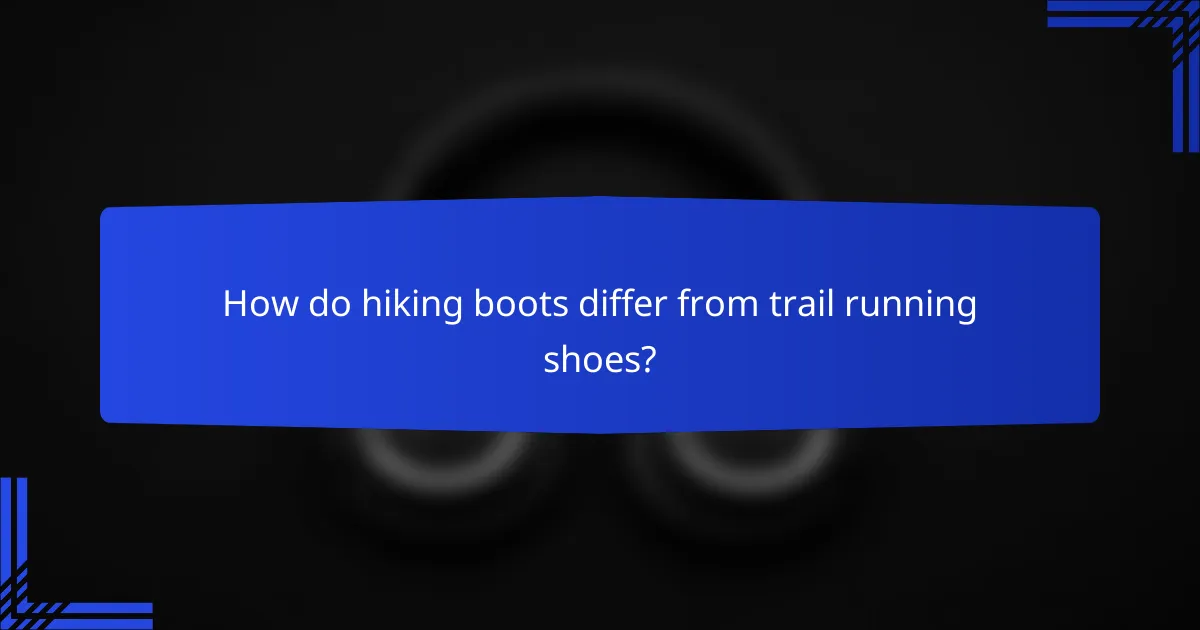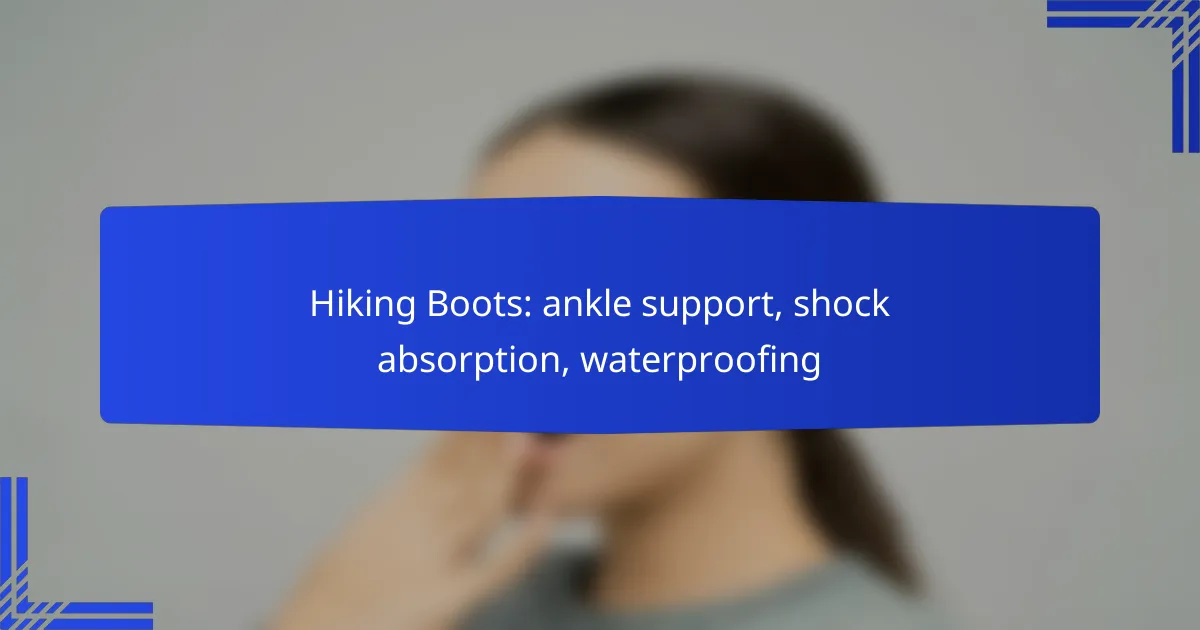When choosing hiking boots, it’s essential to consider ankle support, shock absorption, and waterproofing to ensure a comfortable and safe experience on the trails. Boots with mid-cut designs and robust materials provide the necessary stability and protection, while cushioned midsoles help absorb impact and reduce stress on your joints. Additionally, look for waterproof features like GORE-TEX linings to keep your feet dry in wet conditions, allowing you to focus on enjoying your hike.

What are the best hiking boots for ankle support in New Zealand?
The best hiking boots for ankle support in New Zealand are designed to provide stability and protection on rugged terrain. Look for boots that feature a mid-cut design, robust materials, and cushioning to enhance comfort during long hikes.
Salomon X Ultra 3 Mid GTX
The Salomon X Ultra 3 Mid GTX is renowned for its excellent ankle support and waterproof capabilities. Its mid-height design helps stabilize the ankle while navigating uneven surfaces, making it a solid choice for New Zealand’s diverse trails.
This boot features a Gore-Tex lining that keeps feet dry in wet conditions, which is essential given New Zealand’s variable weather. Additionally, the Contagrip outsole provides superior traction on both wet and dry surfaces, enhancing safety during hikes.
Merrell Moab 2 Mid Waterproof
The Merrell Moab 2 Mid Waterproof is another top contender for ankle support, offering a comfortable fit and reliable performance. Its cushioned footbed and supportive midsole help absorb shock, reducing fatigue on longer hikes.
This boot is equipped with a waterproof membrane that ensures your feet stay dry, even in the rain-soaked regions of New Zealand. The Vibram outsole delivers excellent grip, making it suitable for various terrains, from rocky paths to muddy trails.

How do hiking boots provide shock absorption?
Hiking boots provide shock absorption primarily through their design features that mitigate impact during movement. Key components like cushioned midsoles and impact-resistant outsoles work together to reduce stress on the feet and joints, enhancing comfort and stability on rugged terrain.
Cushioned midsoles
Cushioned midsoles are a critical element in hiking boots, designed to absorb shock and provide comfort. Typically made from materials like EVA (ethylene-vinyl acetate) or polyurethane, these midsoles help distribute weight evenly, reducing pressure on the feet during long hikes.
When selecting hiking boots, look for those with thicker midsoles for better shock absorption, especially if you plan to trek over rocky or uneven surfaces. A good rule of thumb is to choose boots with a midsole thickness of at least 2-3 cm for optimal cushioning.
Impact-resistant outsoles
Impact-resistant outsoles are essential for protecting your feet from sharp objects and uneven ground. These outsoles are typically made from durable rubber compounds that provide traction and stability while absorbing shocks from impacts.
When evaluating hiking boots, consider the outsole’s tread pattern and material. A deeper tread can enhance grip on slippery surfaces, while a stiffer outsole can offer better shock absorption. Look for boots with outsoles that meet industry standards for durability, ensuring they can withstand various hiking conditions.

What features ensure waterproofing in hiking boots?
Waterproofing in hiking boots is primarily achieved through specialized materials and construction techniques that prevent water from entering while allowing moisture to escape. Key features include GORE-TEX linings and waterproof leather uppers, which work together to keep your feet dry in wet conditions.
GORE-TEX lining
GORE-TEX is a popular waterproof membrane that is both breathable and durable, making it ideal for hiking boots. This material allows sweat vapor to escape while blocking water from entering, keeping your feet comfortable during long hikes.
When selecting boots with GORE-TEX lining, look for models that specify the thickness and quality of the membrane, as these factors can influence overall performance. It’s also important to ensure that the boots fit well, as a proper fit enhances the effectiveness of the waterproofing.
Waterproof leather uppers
Waterproof leather uppers provide a classic and effective barrier against moisture. Full-grain leather is often treated with waterproofing agents, making it resistant to water while maintaining breathability.
When considering waterproof leather boots, check for features like sealed seams and water-resistant coatings, which enhance their ability to repel water. Regular maintenance, such as applying leather conditioner and waterproofing sprays, can significantly extend the life and performance of these boots.

What should I consider when choosing hiking boots?
When choosing hiking boots, prioritize fit, comfort, terrain type, ankle support, shock absorption, and waterproofing. These factors will significantly impact your hiking experience and help prevent injuries.
Fit and comfort
Fit and comfort are crucial for hiking boots, as a proper fit reduces the risk of blisters and discomfort during long hikes. Ensure there is enough room in the toe box and that the heel fits snugly to prevent slipping.
Consider trying on boots with the socks you plan to wear while hiking, and walk around to assess comfort. A good rule of thumb is to have about a thumb’s width of space between your longest toe and the front of the boot.
Terrain type
The type of terrain you plan to hike on will influence your choice of hiking boots. For rocky or uneven surfaces, opt for boots with stiffer soles and good traction to provide stability and support.
If you expect to encounter wet conditions, choose waterproof boots that feature breathable materials. For lighter trails, you might consider trail runners, which offer less support but are more lightweight and flexible.

How do I properly break in hiking boots?
To properly break in hiking boots, start by wearing them for short periods indoors before gradually using them outdoors. This approach helps to ensure comfort and reduces the risk of blisters during longer hikes.
Wear them indoors
Begin by wearing your hiking boots indoors for a few hours at a time over several days. This allows your feet to adjust to the fit and helps the materials to soften without the stress of outdoor conditions. Aim for around 2-4 hours daily, focusing on activities like walking around the house or doing light chores.
Pay attention to any pressure points or discomfort. If you notice areas that feel tight or painful, consider adjusting the lacing or using thicker socks to help with the fit. This initial phase is crucial for identifying potential issues before hitting the trails.
Gradually increase outdoor use
Once your boots feel comfortable indoors, start taking them on short outdoor walks. Begin with flat, easy terrain for 30 minutes to an hour, and gradually increase the duration and difficulty of your hikes. This step allows your boots to adapt to various surfaces while your feet continue to adjust.
As you progress, incorporate different terrains and inclines into your hikes. Monitor how your feet feel during and after each outing, and be prepared to take breaks if discomfort arises. A gradual approach helps prevent blisters and ensures that your boots are fully broken in before tackling more challenging hikes.

What are the top brands for hiking boots in New Zealand?
The leading brands for hiking boots in New Zealand include Scarpa and Columbia, known for their durability, comfort, and performance in rugged terrains. These brands offer a variety of models tailored to different hiking needs, ensuring that outdoor enthusiasts can find suitable options for their adventures.
Scarpa
Scarpa is renowned for producing high-quality hiking boots that provide excellent ankle support and stability. Their boots often feature advanced materials and technologies, such as Gore-Tex for waterproofing and Vibram soles for superior traction on various surfaces.
When selecting Scarpa boots, consider models like the Scarpa Zodiac GTX, which balances weight and durability, making it ideal for both day hikes and multi-day treks. Ensure a proper fit, as Scarpa boots tend to run narrow, which may require trying on different sizes or widths.
Columbia
Columbia offers a range of hiking boots that emphasize comfort and affordability without sacrificing performance. Their boots often incorporate technologies like Omni-Tech for waterproofing and lightweight cushioning for shock absorption, making them suitable for casual hikers and serious adventurers alike.
Popular models include the Columbia Newton Ridge Plus, which is known for its versatility and comfort on various terrains. When choosing Columbia boots, pay attention to the intended use; lighter models are great for day hikes, while more robust options are better for challenging trails.

How do hiking boots differ from trail running shoes?
Hiking boots are designed for rugged terrain and provide more ankle support and protection than trail running shoes, which are lighter and more flexible for speed. The key differences lie in their construction, intended use, and features like cushioning and waterproofing.
Support and stability
Hiking boots offer superior support and stability, particularly around the ankle, which is crucial for uneven and rocky trails. This support helps prevent injuries such as sprains, making them ideal for long hikes with heavy packs.
In contrast, trail running shoes prioritize flexibility and lightweight design, which can enhance speed but may compromise ankle support. For those tackling challenging terrains, choosing boots with a higher cut can provide additional security.
Durability and protection
Hiking boots are built with durable materials designed to withstand harsh conditions, including abrasion-resistant fabrics and reinforced toe caps. This durability ensures that they can handle rough trails and protect your feet from sharp rocks and debris.
Trail running shoes, while often made from lightweight materials for breathability, may not offer the same level of protection. They are suitable for less demanding environments but may wear out quickly on rugged paths. When selecting hiking boots, look for features like waterproofing and sturdy soles to enhance longevity and comfort during extended hikes.

What are the latest trends in hiking boot technology?
The latest trends in hiking boot technology focus on enhancing comfort, durability, and environmental sustainability. Innovations include the use of eco-friendly materials, smart technology integration, and improved features for ankle support, shock absorption, and waterproofing.
Eco-friendly materials
Many hiking boot manufacturers are increasingly using sustainable materials to reduce their environmental impact. This includes recycled plastics, organic cotton, and biodegradable components, which help minimize waste and pollution.
When selecting eco-friendly hiking boots, look for certifications such as Global Recycled Standard (GRS) or OEKO-TEX, which indicate responsible sourcing and manufacturing practices. Brands like Merrell and Salomon are leading the way in this area, offering options that balance performance with sustainability.
Smart technology integration
Smart technology is becoming more prevalent in hiking boots, with features like built-in sensors that track distance, elevation, and even foot pressure. This data can help hikers optimize their performance and prevent injuries by providing insights into their gait and foot health.
Some boots now come equipped with Bluetooth connectivity, allowing users to sync their data with mobile apps for a comprehensive overview of their hiking activities. While these high-tech features can enhance the hiking experience, consider the trade-off of battery life and the potential need for maintenance.
